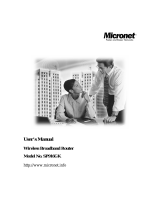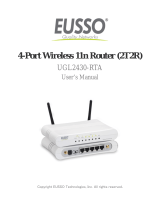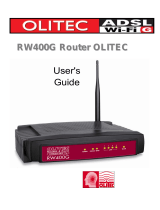Page is loading ...

Wireless 11n AP Router
2T2R
Rev: 1.0.1rp

FCC STATEMENT
This equipment has been tested and found to comply with the limits for a Class B digital device,
pursuant to part 15 of the FCC Rules. These limits are designed to provide reasonable protection
against harmful interference in a residential installation. This equipment generates, uses and can
radiate radio frequency energy and, if not installed and used in accordance with the instructions,
may cause harmful interference to radio communications. However, there is no guarantee that
interference will not occur in a particular installation. If this equipment does cause harmful
interference to radio or television reception, which can be determined by turning the equipment off
and on, the user is encouraged to try to correct the interference by one or more of the following
measures:
• Reorient or relocate the receiving antenna.
• Increase the separation between the equipment and receiver.
• Connect the equipment into an outlet on a circuit different from that to which the receiver
is connected.
• Consult the dealer or an experienced radio/ TV technician for help.
This device complies with part 15 of the FCC Rules. Operation is subject to the following two
conditions:
1) This device may not cause harmful interference.
2) This device must accept any interference received, including interference that may cause
undesired operation.
Any changes or modifications not expressly approved by the party responsible for compliance
could void the user’s authority to operate the equipment.
NOTE: THE MANUFACTURER IS NOT RESPONSIBLE FOR ANY RADIO OR TV
INTERFERENCE CAUSED BY UNAUTHORIZED MODIFICATIONS TO THIS EQUIPMENT.
SUCH MODIFICATIONS COULD VOID THE USER’S AUTHORITY TO OPERATE THE
EQUIPMENT.
FCC RF Radiation Exposure Statement
This equipment complies with FCC RF radiation exposure limits set forth for an uncontrolled
environment. This device and its antenna must not be co-located or operating in conjunction with
any other antenna or transmitter.
“To comply with FCC RF exposure compliance requirements, this grant is applicable to only
Mobile Configurations. The antennas used for this transmitter must be installed to provide a
separation distance of at least 20 cm from all persons and must not be co-located or operating in
conjunction with any other antenna or transmitter.”

CE Mark Warning
This is a class B product. In a domestic environment, this product may cause radio interference, in
which case the user may be required to take adequate measures.
National restrictions
This device is intended for home and office use in all EU countries (and other countries following
the EU directive 1999/5/EC) without any limitation except for the countries mentioned below:
Country Restriction Reason/remark
Bulgaria None
General authorization required for outdoor use and
public service
France
Outdoor use limited to 10
mW e.i.r.p. within the band
2454-2483.5 MHz
Military Radiolocation use. Refarming of the 2.4 GHz
band has been ongoing in recent years to allow current
relaxed regulation. Full implementation planned 2012
Italy None
If used outside of own premises, general authorization is
required
Luxembourg None
General authorization required for network and service
supply(not for spectrum)
Norway Implemented
This subsection does not apply for the geographical area
within a radius of 20 km from the centre of Ny-Ålesund
Russian Federation None Only for indoor applications
Note: Please don’t use the product outdoors in France.

CONTENTS
Package Contents..................................................................................................................................1
Chapter 1. Introduction .......................................................................................................................2
1.1 Overview .............................................................................................................................2
1.2 Main Features .....................................................................................................................3
1.3 Panel Layout .......................................................................................................................4
1.3.1 The Front Panel ......................................................................................................4
1.3.2 The Rear Panel ......................................................................................................5
Chapter 2. Connecting the Router .....................................................................................................6
2.1 System Requirements .........................................................................................................6
2.2 Installation Environment Requirements ..............................................................................6
2.3 Connecting the Router ........................................................................................................6
Chapter 3. Quick Installation Guide ...................................................................................................7
3.1 TCP/IP Configuration ..........................................................................................................8
3.2 Quick Installation Guide ....................................................................................................10
Chapter 4. Configuring the Router ..................................................................................................16
4.1 Login .................................................................................................................................16
4.2 Status ................................................................................................................................16
4.3 Quick Setup .......................................................................................................................17
4.4 WPS ..................................................................................................................................17
4.5 TCP/IP Settings .................................................................................................................20
4.5.1 LAN .......................................................................................................................20
4.5.2 WAN Interface ......................................................................................................21
4.6 Wireless ............................................................................................................................29
4.6.1 Basic Settings .......................................................................................................29
4.6.2 Advanced Settings ................................................................................................31
4.6.3 Security .................................................................................................................32
4.6.4 Access Control .....................................................................................................37
4.6.5 WDS Settings .......................................................................................................38
4.6.6 Site Survey ...........................................................................................................40
4.6.7 WPS ......................................................................................................................41
4.6.8 Schedule ...............................................................................................................42
- I -

4.7 Firewall ..............................................................................................................................43
4.7.1 Port Filtering .........................................................................................................43
4.7.2 IP Filtering .............................................................................................................44
4.7.3 MAC Filtering ........................................................................................................44
4.7.4 Port Forwarding ....................................................................................................45
4.7.5 URL Filtering .........................................................................................................46
4.7.6 DMZ ......................................................................................................................46
4.7.7 VLAN ....................................................................................................................47
4.8 QoS ...................................................................................................................................48
4.9 Management .....................................................................................................................48
4.9.1 Status ....................................................................................................................49
4.9.2 Statistics ................................................................................................................49
4.9.3 DDNS ....................................................................................................................50
4.9.4 Time Zone Setting ................................................................................................51
4.9.5 Denial-of-Service ..................................................................................................52
4.9.6 Log ........................................................................................................................53
4.9.7 Upgrade Firmware ................................................................................................54
4.9.8 Save/Reload Setting .............................................................................................55
4.9.9 Password ..............................................................................................................56
Appendix A: FAQ .................................................................................................................................57
Appendix B: Configuring the PC .......................................................................................................58
Appendix C: Specifications ................................................................................................................61
Appendix D: Glossary .........................................................................................................................62
- II -

RTK 11n AP
Package Contents
The following items should be found in your package:
RTK 11N AP
Power Adapter
Quick Installation Guide
Note:
Make sure that the package contains the above items. If any of the listed items are damaged or
missing, please contact your distributor.
- 1 -

RTK 11n AP
Chapter 1. Introduction
Thank you for choosing the RTK 11N AP.
1.1 Overview
The RTK 11N AP integrates 4-port Switch, Firewall, NAT-Router and Wireless AP. The RTK 11N AP
delivers exceptional range and speed, which can fully meet the need of Small Office/Home Office
(SOHO) networks and users that demand higher networking performance.
The RTK 11N AP provides up to 300M wireless connection with other 802.11n wireless clients. The
speed makes it ideal for handling multiple data streams at the same time ensuring your network
stability. It is compatible with all IEEE 802.11g and IEEE 802.11b products.
t
The multiple protection measures include SSID broadcast control and wireless LAN 64/128-bit
WEP encryption, Wi-Fi protected Access (WPA2- PSK, WPA- PSK), as well as advanced Firewall
protections. The RTK 11N AP provides complete data privacy.
RTK 11N AP Router provides flexible access control for parents and network administrators to
establish restricted access policies for children or staff members. It also supports Virtual Server and
DMZ host. The network administrators can manage and monitor the network in real time with the
remote management function.
Since the Router is compatible with virtually all the major operating systems, it is easy to manage
and operate. The Quick Setup Wizard is supported and detailed step by step instructions are in
this user guide. Before installing the Router, please look through the user guide to know all the
Router’s functions.
Simple Installation
Flexible Access Control
Multiple Security Protections
Incredible Speed
- 2 -

RTK 11n AP
1.2 Main Features
IEEE 802.11n wireless technology to provide a wireless data rate of up to 300Mbps.
One 10/100M Auto-Negotiation RJ45 WAN port, four 10/100M Auto-Negotiation RJ45 LAN
ports, supporting Auto MDI/MDIX.
Provides WPA/WPA2, WPA-PSK/WPA2-PSK authentication, TKIP/AES encryption security.
Shares data and Internet access for users, supporting Dynamic IP/Static IP/PPPoE Internet
access.
Supports Virtual Server, Special Application and DMZ host.
Supports UPnP, Dynamic DNS, Static Routing.
Provides Automatic-connection and Scheduled Connection to the Internet on specified times.
Connects Internet on demand and disconnects from the Internet when idle for PPPoE.
Built-in NAT and DHCP server supporting static IP address distribution.
Supports Stateful Packet Inspection.
Supports VPN Passthrough.
Supports Parental Control and Access Control.
Provides 64/128-bit WEP encryption security and wireless LAN ACL (Access Control List).
Supports Flow Statistics.
Supports firmware upgrade and Web management.
Supports 12V passive PoE onboard
- 3 -

RTK 11n AP
1.3 Panel Layout
1.3.1 The Front Panel
The Router’s LEDs and the WPS/Reset Button are located on the side panel (View from left to
right).
Name Status Indication
PWR
Off
Power is off.
On
Power is on.
SYS On Push the Reset button
WLAN
Off
The Wireless function is disabled or not active
Flashing
The Wireless active
WAN,
1,2,3,4 (LAN)
Off
There is no device linked to the corresponding port.
On
There is a device linked to the corresponding port but
there is no activity.
Flashing
There is an active device linked to the corresponding port.
WPS
Slow Flash
A wireless device is connected to the network by WPS
function. This process will last for about 2 minutes.
On
A wireless device has been successfully added to the
network by WPS function. The LED will light up for about
2 minutes.
Quick Flash
A wireless device failed to be added to the network by
WPS function.
Table 1-1 The LEDs Description
Note:
1. After the device has been successfully added to the network by the WPS function, the WPS
LED will light up for about 2 minutes and then turn off.
2. To reset the router, press the Reset Button and hold for more than five seconds.
- 4 -

RTK 11n AP
1.3.2 The Rear Panel
Figure 1-2 Rear Panel sketch
The following parts are located on the rear panel (View from left to right).
POWER: The Power socket is where you will connect the power adapter. Please use the
power adapter provided with the RTK 11N AP.
WAN: The WAN port is where you will connect the DSL/cable Modem, or Ethernet. The
Ethernet port’s pin 4,5,7,8 is designed pin to ground possess 12V Passive PoE input
1,2,3,4 (LAN): Ports (1, 2, 3, and 4) to connect the Router to the local PC(s). The LAN 1
port’s pin 4,5,7,8 is designed pin to ground possess 12V Passive PoE
input and the LAN4 port possess 12V Passive PoE out.
Wireless antenna: To receive and transmit the wireless data.
- 5 -

RTK 11n AP
Chapter 2. Connecting the Router
2.1 System Requirements
Broadband Internet Access Service (DSL/Cable/Ethernet)
One DSL/Cable Modem that has an RJ45 connector (which is not necessary if the Router is
connected directly to the Ethernet.)
PCs with a working Ethernet Adapter and an Ethernet cable with RJ45 connectors
TCP/IP protocol on each PC
Web browser, such as Microsoft Internet Explorer, Mozilla Firefox or Apple Safari
2.2 Installation Environment Requirements
Place the Router in a well-ventilated place away from any heater or heating vent
Avoid direct irradiation of any strong light (such as sunlight)
Keep at least 2 inches (5 cm) of clear space around the Router
Operating Temperature: -20℃~60℃
Operating Humidity: 10%~90%RH, Non-condensing
2.3 Connecting the Router
Before installing the Router, make sure your PC is connected to the Internet through the
broadband service successfully. If there is any problem, please contact your ISP. Install the Router
according to the following steps. Don't forget to pull out the power plug and keep your hands dry.
1. Turn the power off for your PC, Cable/DSL Modem, and the Router.
2. Locate an optimum location for the Router. The best place is usually at the center of your
wireless network environment.
3. Adjust the direction of the antenna. Normally, upright is a good direction.
4. Connect the PC(s) and each Switch/Hub in your LAN to the LAN Ports on the Router, shown
in Figure 2-1. (If you have the wireless NIC and want to use the wireless function, you can
skip this step.)
5. Connect the DSL/Cable Modem to the WAN port on the Router, shown in Figure 2-1.
- 6 -

RTK 11n AP
6. Connect the power adapter to the power socket on the Router, and the other end into an
electrical outlet. Or connect the 12V passive PoE injector (option) to WAN or LAN1 port
(PoE input). Press the power switch, and then the router will start to work.
7. Turn the power on for your PC and Cable/DSL Modem.
Figure 2-1 Hardware Installation of the RTK 11N AP
WARNING !!!
This router supports Passive PoE 12VDC only.
Exceeding voltage may result damage and VOID WARRANTY.
- 7 -

RTK 11n AP
Chapter 3. Quick Installation Guide
This chapter will show you how to configure the basic functions of your RTK 11N AP using Quick
Setup Wizard within minutes.
3.1 TCP/IP Configuration
The default IP address for RTK 11N AP is 192.168.2.1. And the default Subnet Mask is
255.255.255.0. These values can be changed to your preference.
Connect the local PC to the LAN ports of the RTK 11N AP. You can configure the IP address for
your PC with the following options.
Configure the IP address manually
1) Set up the TCP/IP Protocol for your PC. If you need instructions as to how to do this,
please refer to
Appendix B: Configuring the PC.
2) Configure the network parameters. The IP address is 192.168.2.xxx ("xxx" represents
any number from 2 to 254), Subnet Mask is 255.255.255.0, and Gateway is 192.168.2.1
(The Router's default IP address).
Obtain an IP address automatically
1) Set up the TCP/IP Protocol in "Obtain an IP address automatically" mode on your PC.
If you need instructions as to how to do this, please refer to
Appendix B: Configuring the
PC.
2) The built-in DHCP server will assign an IP address for the PC.
Now, you can run the Ping command in the command prompt to verify the network connection
between your PC and the Router. The following example is in Windows XP OS.
Open a command prompt, and type ping 192.168.2.1, and then press Enter.
If the result displayed is similar to the Figure 3-1, it means the connection between your PC
and the Router has been established well.
- 8 -

RTK 11n AP
Figure 3-1 Success result of Ping command
If the result displayed is similar to the Figure 3-2, it means the connection between your PC
and the Router has failed.
Figure 3-2 Failure result of Ping command
To check the connection follow these steps:
1. Is the connection between your PC and the Router correct?
Note:
The 1/2/3/4 LEDs of LAN ports which you link to on the Router and LEDs on your PC's adapter
should be lit.
2. Is the TCP/IP configuration for your PC correct?
Note:
The Router's IP address is 192.168.2.1. Your PC's IP address must be within the range of
192.168.2.2 ~ 192.168.2.254.
- 9 -

RTK 11n AP
3.2 Quick Installation Guide
With a Web-based utility, it is easy to configure and manage RTK 11N AP. The Web-based utility
can be used on any Windows, Macintosh or UNIX OS with a Web browser, such as Microsoft
Internet Explorer, Mozilla Firefox or Apple Safari.
1. To access the configuration utility, open a web-browser and type in the default address
http://192.168.2.1
in the address field of the browser.
Figure 3-3 Log in the Router
A login window may pop up; leave the User Name and Password blank. Then click OK or
press Enter.
2. After successfully logging in, click the Quick Setup menu to quickly configure your Router.
Figure 3-4 Quick Setup
- 10 -

RTK 11n AP
3. Click Next, and then Operation Mode page will appear, shown in Figure 3-5.
Figure 3-5 Quick Setup - WAN Connection Type
The Router provides three popular ways Gateway, Bridge and Wireless ISP to connect to
the Internet. It’s recommended that you make use of the Gateway function. If you are sure of
what kind of connection type your ISP provides, you can select the very type and click Next to
go on configuring.
4. If you are sure of what kind of NTP server your Router, you can select the very type and click
Next to go on configuring as shown in Figure 3-6.
Figure 3-6 Quick Setup - Time Zone Setting
- 11 -

RTK 11n AP
5. Confirm the IP address for your Router and click Next to continue configuration.
Figure 3-7 Quick Setup - LAN Interface Setting
6. If you select Gateway, the Router provides six connection types for your ISP provides. Make
sure the cable is securely plugged into the WAN port before continuing.
a) If the connection type is PPPoE, then select it from drop down menu as shown below.
Enter the User Name and Password provided by your ISP, and click Next.
Figure 3-8 Quick Setup - WAN Interface Setting
User Name/Password - Enter the User Name and Password provided by your ISP.
These fields are case sensitive. If you have difficulty with this process, please contact
your ISP.
- 12 -

RTK 11n AP
b) If the connection type detected is DHCP Client, the next screen will appear as shown in
Figure 3-9. You can then proceed with the wireless configuration.
Figure 3-9 Quick Setup - DHCP
c) If the connection type detected is Static IP, the next screen will appear as shown in
Figure 3-10.
Figure 3-10 Quick Setup - Static IP
IP Address - This is the WAN IP address as seen by external users on the Internet
(including your ISP). Enter the IP address into the field.
Subnet Mask - The Subnet Mask is used for the WAN IP address, usually
255.255.255.0.
Default Gateway - Enter the gateway IP address into the box if required.
Primary DNS - Enter the DNS Server IP address into the box if required.
- 13 -

RTK 11n AP
7. Click Next to continue, the Wireless settings page will appear as shown in Figure 3-11.
Figure 3-11 Quick Setup – Wireless
Band: Keep the default setting: 2.4GHz (B+G+N). If you just want to use a specific
protocol, please use the drop down menu to select it.
Mode: This field determines the wireless mode which the RTK 11N AP works on.
Network Type: Keep the default setting: Infrastructure. If you just want to use another
operation mode, please use the drop down menu to select it.
SSID: Create a unique and easy way to remember the name of your wireless network.
You can also keep default settings without the device being affected.
Channel Width - Select any channel width from the pull-down list. The default setting is
automatic therefore it can adjust the channel width for your clients automatically.
Channel Number- This field determines which operating frequency will be used. The
default channel is set to Auto allowing the RTK 11N AP to choose the best channel
automatically. It is not necessary to change the wireless channel unless you notice
interference problems with another nearby access point.
- 14 -

RTK 11n AP
8. Set your security preference then click the Finished button.
Wireless Security: Recommend to choose WPA-PSK/WPA2-PSK and enter a Security Key
using ASCII characters between 8 and 63 characters or 64 hexadecimal characters in the
PSK Password filed. For advanced settings, please refer to
Section 4.6: “Wireless”.
WPA-PSK/WPA2-PSK - Select WPA based on pre-shared passphrase.
PSK Password - You can enter ASCII or Hexadecimal characters.
For ASCII, the key can be made up of any numbers from 0 to 9 and any letters from
A to Z, the length should be between 8 and 63 characters.
For Hexadecimal, the key can be made up of any numbers 0 to 9 and letters A to F,
the length should be between 8 and 64 characters.
Please note the key is case sensitive, therefore the upper and lower case keys will
affect the outcome. It is highly recommended to write down the key and all related
wireless security settings.
Figure 3-12 Quick Setup - Finish
- 15 -
/




